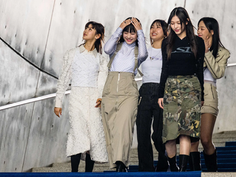Art as a Mirror of Social Change
- Dia Upreti
- Nov 10, 2024
- 3 min read
Diya Upreti, Jadetimes Staff
Diya Upreti is a Jadetimes news reporter covering Culture News

Art as a Mirror of Social Change: How Artists Respond to Global Issues such as Climate Change, Human Rights, and Equality
Traditionally, art has always proved itself to be an opening window into the social and political climate of this world as it reflects changes and values and the urgent matters which affect communities worldwide. However, under conditions of turmoil and change, artists must be challenged to express themselves towards the pressing challenges of human society, such as climatic change, human rights, and equality, which are abstract and even complex issues. These could be translated into powerful messages for the audience through the visible expression of these crisis situations which shall create sight and feeling within the audience, hence awakening self-reflection and motivation among them to act upon certain issues.
Art and Climate Change
Climate change is one of the most significant threats our world is facing, and several artists have responded with powerful works that reflect the devastation being perpetrated on the environment. Artists from all walks of life are portraying scenes of pollution, deforestation, and extreme weather events in a visual narrative about ecological degradation. For example, Olafur Eliasson, a Danish-Icelandic artist, has used the melting blocks of glacial ice in widely publicized installations to insert them into urban spaces in order to show how global warming is affecting everything. Activist artists use plastics or metals found in such polluted areas to create sculptures that represent the role of human interaction in environmental damage.
These artists are raising awareness through exhibitions, sculptures, and installations, encouraging viewers to reflect on their role in climate action. They make the invisible consequences visible, bringing the issue closer to home, and people take action over issues such as waste reduction, conservation, and sustainability.
Art and Human Rights
Art has been an extended platform for social comment about the issues of human rights within the oppression, discrimination, and injustice arenas. A great deal of space and voice have been opened in artistic works for marginal people as well as around race disparity, gender rights, freedom of speech, among many others. Perhaps no artist has epitomized more than Ai Weiwei on this aspect-who's a Chinese contemporary artist speaking out against the oppressiveness of government authorities as an advocate for human rights. His installations are often representative of a dislocated or detained condition, speaking about the plight of refugees and prisoners of conscience.
Photography and performance art are two methods used by artists to capture injustice stories. The unedited realities are presented in society, creating empathy and unity as it forces the public to face injustices that might otherwise be ignored. An art installation such as JR's global photographic projects makes it possible for the world to see the faces and lives of those whom society turns a blind eye to, reminding us of our humanity.
Art and Equality
One theme that is seen globally is equality on dimensions of gender, race, and economic justice. It is through the artist who addresses these themes of focusing on historical and current imbalances that inspires societal revision. Kehinde Wiley creates portraits that are actually reformulations of classic art because it places people of color into traditional European, aristocratic poses. He thereby brings up long-held thoughts in the minds of society: race, beauty, and who is seen or not seen.
Public murals, in recent times, have emerged as a highly powerful medium to call for equality and unison. It celebrates diversity, honors social movements of momentousness, and brings up the voice of the less heard. There are some reasons murals painted on the city walls do that. The black lives matter murals captured in cities all around the world seize the momentum along with demands for justice, which becomes accessible to every individual within the community. It reinforces the fact that public spaces are for all.
Art as a Catalyst for Change
Art gains full power by the transcendence of words and a more direct appeal to emotions. Therefore, artists transform global matters, which otherwise would feel distant or abstract, personal through visual storytelling. It transforms into the instrument of consciousness that crosses borders and gaps of cultures and ideologies to ignite awareness and the need for questioning, reflection, and action. In the face of such issues as climate change, human rights, and equality being global issues, art takes on a life beyond simple reflection; it becomes an appeal to action, a rallying cry for a more compassionate, informed, and just society.
Artists reveal what is hidden and, therefore, not spoken; they hold a mirror to the world, showing it beauty and fractures. In this way, they pave the path toward a more awake and involved society concerning the issues that shape our future.



























Comments